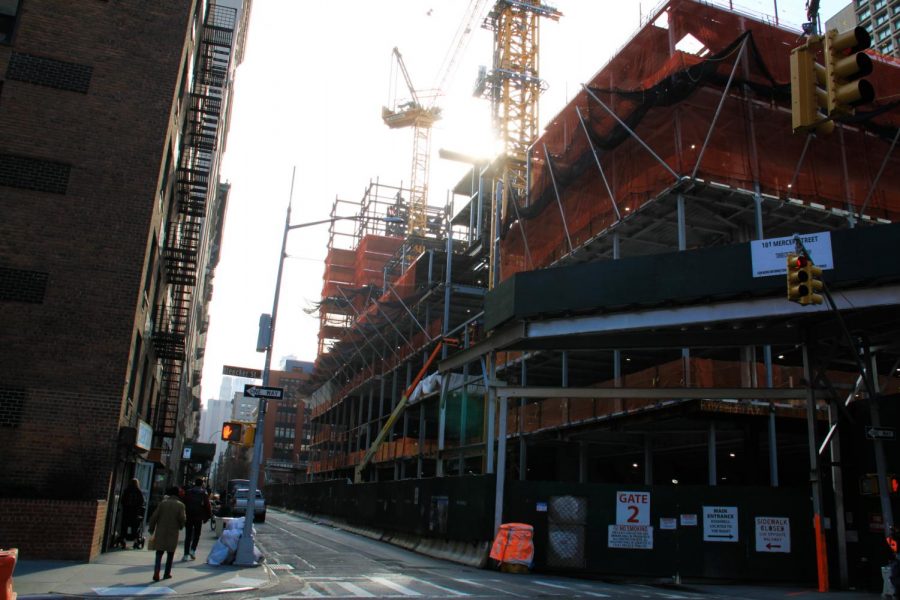Opinion: De Blasio’s rezoning plan is gentrification in the making
Mayor Bill de Blasio pledged to increase access to affordable housing for SoHo, NoHo and Chinatown residents with a controversial upzoning plan. The plan, however, will likely instead increase gentrification in NYU’s backyard and reduce net affordable housing. The City Planning Commision should reject it outright.
NYU continues construction on 181 Mercer Street in SoHo gentrifying the area. Mayor DeBlasio’s plan for affordable housing in the area does not serve the public interest of the surrounding area. (Staff Photo by Alexandra Chan)
September 1, 2021
Last year, Mayor Bill de Blasio’s office introduced a rezoning plan targeting much of SoHo, NoHo and parts of Chinatown. The city has emphasized the plan’s potential to create housing and job opportunities that will make SoHo and NoHo more equitable. They highlight a possible figure of 3,200 new affordable homes from rezoning and development. Advocates for the plan say that rezoning will increase socioeconomic diversity within the wealthier, whiter neighborhoods that are notoriously inaccessible for low-income New Yorkers.
A closer analysis of the plan’s fine print, however, reveals that there are many workarounds for real estate developers to avoid building or investing in any affordable housing whatsoever. A report published last May by the Greenwich Village Society for Historic Preservation lists several loopholes and exemptions which actually incentivize development with no affordable housing. Commercial spaces, for example, are excluded from affordable housing requirements, encouraging an influx of commercial real estate, including large retail chains.
Residential spaces under 25,000 square feet are also excluded from affordable housing requirements, creating a clear profit incentive for real estate developers. Of the 16 sites the city has projected for affordable housing development, 14 are less than 12,500 square feet. Developers are therefore not required to construct any affordable housing at all in those sites and instead have a motive to build more market-rate properties that are largely unattainable for lower wage earners. Luxury residential spaces would be far more lucrative for real estate developers than affordable housing, and the city’s plan incentivizes their development.
Although the plan is marketed toward SoHo and NoHo residents and real estate developers, the rezoning sites also include parts of Chinatown. GVSHP’s analysis raises concerns that majority-Asian communities in Chinatown will be displaced and replaced with white residents who are able to afford market-rate housing. Despite the city’s purported vision of integration, real estate interests can use the rezoning plan to accelerate ongoing gentrification in Chinatown. Demographic reports on Chinatown show that the proportion of Asian residents is already in decline while white residents are the fastest-growing demographic in the area.
Asian and low-income residents are highly concentrated within the city’s proposed upzoning areas thanks to rent-regulated housing. There are already over 600 rent-regulated units in the rezoning area that offer a safeguard for poorer New Yorkers who are unable to afford market-rate housing. As a result of the mayor’s rezoning plan, however, these units can become vulnerable to demolition in favor of residential spaces that only require 20% to 30% affordable housing. The plan further incentivizes the demolition of rent-regulated units as a result of underbuilding and upzoning.
These criticisms, raised by GVSHP and other community groups, have been heard by some city officials. Manhattan Community Board 2 rejected the rezoning plan in July, citing concerns that the plan will fail to achieve an increase in affordable housing and will end up displacing low-income New Yorkers currently under rent protection. This resolution is not binding, however. A final vote by the City Planning Commission will ultimately decide the fate of the rezoning plan.
The plan has not stood up to scrutiny from GVSHP or other community organizations who are deeply invested in the struggle for a fairer, more just New York City. According to projected analysis, it will fail to promote integration and accessibility for low-income residents. It is incumbent upon the CPC to listen to the concerns of local community members and organizations and reject the plan altogether. Gentrification disguised as an affordable housing plan is still gentrification.
Contact Asha Ramachandran at [email protected].
























































































































































